5 yen coin
The 5 yen coin (五円硬貨, Go-en kōka) is one denomination of Japanese yen. The current design was first minted in 1959 using Japanese characters known as the "new script", and were also minted from 1948–1958 using "old-script" Japanese characters. Five-yen coins date to 1870 (when, due to the much higher value of the yen, they were minted in gold). The modern-day coin was first produced in 1948 with a different styled inscription. This was changed in 1959 and the design has remained unchanged since.
Japan | |
| Value | 5 Japanese yen |
|---|---|
| Mass | 3.75 g |
| Diameter | 22 mm |
| Center hole diameter | 5 mm |
| Composition | c. 65% Cu c. 35% Zn |
| Years of minting | 1870–present |
| Catalog number | KM 72, 72a, 96.1 and 96.2 |
| Obverse | |
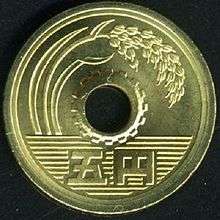 | |
| Design | Rice, water and gear |
| Design date | 1959 |
| Reverse | |
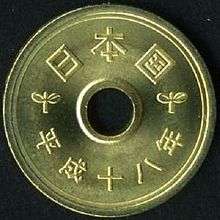 | |
| Design | Tree sprouts |
| Design date | 1959 |
The front of the coin depicts a rice plant growing out of the water, with "five yen" written in kanji; the back is stamped with "Japan" and the year of issue, also in kanji, separated by sprouts of a tree. The three graphic elements of the coin represent agriculture and fisheries, the key elements of the Japanese first-sector economy. Around a hole, there is a gear that represents industry. It is the only Japanese coin in circulation to lack Hindu-Arabic numerals on either face.
Cultural significance
The Japanese for "five yen," go en (五円) is a homophone with go-en (御縁), "en" being a word for causal connection or relationship, and "go" being a respectful prefix. As a result, five-yen coins are commonly given as donations at Shinto shrines with the intention of establishing a good connection with the deity of the shrine, and is widely believed it is best to insert a single five-yen coin into a new wallet before inserting any other money.
Use in nuclear accident investigation
Following the nuclear accident at Tokai, Ibaraki in 1999, physicists Masuchika Kohno and Yoshinobu Koizumi showed how this coin could be used to estimate neutron dosage to the surrounding population, by measuring its zinc isotope ratios. They write:
The Japanese 5-yen coin is about 22 millimeters in diameter and 1.5 mm thick, weighs 3.75 grams and has a central hole 5 mm wide. We chose this coin for monitoring neutron exposure because it is widely circulated, the zinc content is precisely controlled, and the generated has a convenient half-life (244.1 days) and gamma ray energy emission (1,115.5 keV). To obtain a record of the dosage of neutrons released as a result of the accident, we collected exposed coins from people's houses at distances 100–550 m from the facility.[1]
They concluded that the coin could offer information about the total neutron effect during the accident, and about shielding by modern Japanese houses, given that the coins were recovered from indoors.
Circulation figures
Meiji
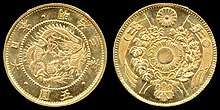
Design 1 - (1870–1871)
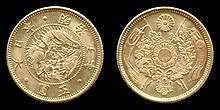
Design 2 - (1872–1897)

Design 3 - (1897–1930[lower-alpha 1])
The following are circulation figures for the coins that were minted between the 3rd, and the 45th and last year of Meiji's reign. Coins for this period all begin with the Japanese symbol 明治 (Meiji). One yen trade dollars and/or patterns are not included here.
- Inscriptions on Japanese coins from this period are read clockwise from right to left:
"Year" ← "Number representing year of reign" ← "Emperor's name" (Ex: 年 ← 五十三 ← 治明)
| Year of reign | Japanese date | Gregorian date | Mintage |
|---|---|---|---|
| 3rd | 三 | 1870 | 273,536[2] |
| 4th | 四 | 1871 | Unknown[2] |
| 5th | 五 | 1872 | 1,057,628[3] |
| 6th | 六 | 1873 | 3,148,925[3] |
| 7th | 七 | 1874 | 728,082[3] |
| 8th | 八 | 1875 | 181,728[3] |
| 9th | 九 | 1876 | 146,226[3] |
| 10th | 十 | 1877 | 136,271[3] |
| 11th | 一十 | 1878 | 101,198[3] |
| 13th | 三十 | 1880 | 78,704[3] |
| 14th | 四十 | 1881 | 149,249[3] |
| 15th | 五十 | 1882 | 113,015[3] |
| 16th | 六十 | 1883 | 108,746[3] |
| 17th | 七十 | 1884 | 113,768[3] |
| 18th | 八十 | 1885 | 200,607[3] |
| 19th | 九十 | 1886 | 179,849[3] |
| 20th | 十二 | 1887 | 179,303[3] |
| 21st | 一十二 | 1888 | 165,794[3] |
| 22nd | 二十二 | 1889 | 353,914[3] |
| 23rd | 三十二 | 1890 | 238,076[3] |
| 24th | 四十二 | 1891 | 216,089[3] |
| 25th | 五十二 | 1892 | 263,103[3] |
| 26th | 六十二 | 1893 | 260,424[3] |
| 27th | 七十二 | 1894 | 314,337[3] |
| 28th | 八十二 | 1895 | 320,090[3] |
| 29th | 九十二 | 1896 | 224,325[3] |
| 30th | 十三 | 1897 (Type 1) | 107,352[3] |
| 30th | 十三 | 1897 (Type 2)[lower-alpha 2] | 111,776[4] |
| 31st | 一十三 | 1898 | 55,888[4] |
| 36th | 六十三 | 1903 | 21,956[4] |
| 44th | 四十四 | 1911 | 59,880[4] |
| 45th | 五十四 | 1912 | 59,880[4] |
Taishō
The following are circulation figures for the coins that were minted during the 2nd and 13th year of Taishō's reign. Coins from this period all begin with the Japanese symbol 大正 (Taishō).
- Inscriptions on Japanese coins from this period are read clockwise from right to left:
- "Year" ← "Number representing year of reign" ← "Emperor's name" (Ex: 年 ← 三十 ← 正大)
| Year of reign | Japanese date | Gregorian date | Mintage |
|---|---|---|---|
| 2nd | 二 | 1913 | 89,820[5] |
| 13th | 三十 | 1924 | 76,037[5] |
Shōwa
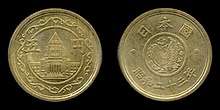
Design 1 - (1948–1949)
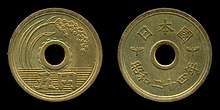
Design 2 - (1949–1958)
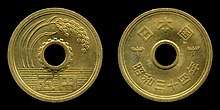
Design 3 - (1959–present)
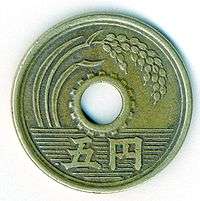
(Pre-1959)
The following are circulation dates which cover Emperor Hirohito's reign. The dates below correspond with the 23rd to the 64th year (last) of his reign. All five yen coins that were made before 1959 use kyūjitai, or old script Japanese. In 1949 only, two different styles of writing were used before a more modern one was established in 1950. This second style of writing was used until 1958 when the current script of Japanese took its place in the following year. Coins for this period will all begin with the Japanese symbol 昭和 (Shōwa).
- Japanese coins are read with a left to right format:
- "Emperor's name" → "Number representing year of reign" → "Year" (Ex: 昭和 → 四十八 → 年).
| Year of reign | Japanese date | Gregorian date | Mintage[6][7][lower-alpha 3] |
|---|---|---|---|
| 5th | 五 | 1930 (Gold) | 852,563[lower-alpha 4] |
| 23rd | 二十三 | 1948 | 74,520,000 |
| 24th | 二十四 | 1949 (Type 1) | 179,692,000 |
| 24th | 二十四 | 1949 (Type 2)[lower-alpha 5] | 111,896,000 |
| 25th | 二十五 | 1950 | 181,824,000 |
| 26th | 二十六 | 1951 | 197,980,000 |
| 27th | 二十七 | 1952 | 55,000,000 |
| 28th | 二十八 | 1953 | 45,000,000 |
| 32nd | 三十二 | 1957 | 10,000,000 |
| 33rd | 三十三 | 1958 (Old script) | 50,000,000 |
| 34th | 三十四 | 1959 (New script) | 33,000,000 |
| 35th | 三十五 | 1960 | 34,800,000 |
| 36th | 三十六 | 1961 | 61,000,000 |
| 37th | 三十七 | 1962 | 126,700,000 |
| 38th | 三十八 | 1963 | 171,800,000 |
| 39th | 三十九 | 1964 | 379,700,000 |
| 40th | 四十 | 1965 | 384,200,000 |
| 41st | 四十一 | 1966 | 163,100,000 |
| 42nd | 四十二 | 1967 | 26,000,000 |
| 43rd | 四十三 | 1968 | 114,000,000 |
| 44th | 四十四 | 1969 | 240,000,000 |
| 45th | 四十五 | 1970 | 340,000,000 |
| 46th | 四十六 | 1971 | 362,050,000 |
| 47th | 四十七 | 1972 | 562,950,000 |
| 48th | 四十八 | 1973 | 745,000,000 |
| 49th | 四十九 | 1974 | 950,000,000 |
| 50th | 五十 | 1975 | 970,000,000 |
| 51st | 五十一 | 1976 | 200,000,000 |
| 52nd | 五十二 | 1977 | 340,000,000 |
| 53rd | 五十三 | 1978 | 318,000,000 |
| 54th | 五十四 | 1979 | 317,000,000 |
| 55th | 五十五 | 1980 | 385,000,000 |
| 56th | 五十六 | 1981 | 95,000,000 |
| 57th | 五十七 | 1982 | 455,000,000 |
| 58th | 五十八 | 1983 | 410,000,000 |
| 59th | 五十九 | 1984 | 202,850,000 |
| 60th | 六十 | 1985 | 153,150,000 |
| 61st | 六十一 | 1986 | 113,960,000 |
| 62nd | 六十二 | 1987 | 631,775,000 |
| 63rd | 六十三 | 1988 | 396,120,000 |
| 64th | 六十四 | 1989 | 67,332,000 |
Heisei
The following are circulation dates in the reign of the current Emperor Emeritus. Akihito was crowned in 1989, which is marked with a 元 symbol on the coin as a one year type. Coins for this period all begin with the Japanese symbol 平成 (Heisei).
- Japanese coins are read with a left to right format:
- "Emperors name" → "Number representing year of reign" → "Year" (Ex: 平成 → 二十六 → 年).
| Year of reign | Japanese date | Gregorian date | Mintage [6][lower-alpha 3] |
|---|---|---|---|
| 1st | 元 | 1989 | 960,660,000 |
| 2nd | 二 | 1990 | 520,953,000 |
| 3rd | 三 | 1991 | 517,120,000 |
| 4th | 四 | 1992 | 301,130,000 |
| 5th | 五 | 1993 | 413,240,000 |
| 6th | 六 | 1994 | 197,767,000 |
| 7th | 七 | 1995 | 351,874,000 |
| 8th | 八 | 1996 | 207,213,000 |
| 9th | 九 | 1997 | 239,086,000 |
| 10th | 十 | 1998 | 172,612,000 |
| 11th | 十一 | 1999 | 60,120,000 |
| 12th | 十二 | 2000 | 9,030,000 |
| 13th | 十三 | 2001 | 78,025,000 |
| 14th | 十四 | 2002 | 143,662,000 |
| 15th | 十五 | 2003 | 102,406,000 |
| 16th | 十六 | 2004 | 70,903,000 |
| 17th | 十七 | 2005 | 16,029,000 |
| 18th | 十八 | 2006 | 9,594,000 |
| 19th | 十九 | 2007 | 9,904,000 |
| 20th | 二十 | 2008 | 9,811,000 |
| 21st | 二十一 | 2009 | 4,003,000 |
| 22nd | 二十二 | 2010 | 510,000 |
| 23rd | 二十三 | 2011 | 456,000 |
| 24th | 二十四 | 2012 | 659,000 |
| 25th | 二十五 | 2013 | 554,000 |
| 26th | 二十六 | 2014 | 87,538,000 |
| 27th | 二十七 | 2015 | 105,004,000 |
| 28th | 二十八 | 2016 | 35,064,000 |
| 29th | 二十九 | 2017 | 33,927,000 |
| 30th | 三十 | 2018 | 17,960,000 |
| 31st | 三十一 | 2019 | 16,946,000 |
Reiwa
The following are circulation dates in the reign of the current Emperor. Naruhito's accession to the Crysanthemum Throne took place on May 1, 2019 and he was formally enthroned on October 22, 2019. Coins for this period all begin with the Japanese symbol 令和 (Reiwa). The inaugural year coin (2019) was marked 元 (first) and debuted during the summer of that year.[8]
| Year of reign | Japanese date | Gregorian date | Mintage[6][lower-alpha 3] |
|---|---|---|---|
| 1st | 元 | 2019 | 20,574,000 |
| 2nd | 二 | 2020 | TBD |
Notes
- The third and final gold coin design was also used during Taishō, and Shōwa's reign.
- Two coin designs were made in 1897, the second type is smaller as the weight was changed from 8.3 to 4.2 grams
- Mintages on the Japan Mint website are in thousands
- Many of these 1930 dated gold coins were possibly melted or destroyed during World War II
- Two coin designs were made in 1949, the second type resembles the current one in use today.
References
- Kohno, Masuchika; and Yoshinobu Koizumi (2000). "Tokaimura accident: Neutron dose estimates from 5-yen coins". Nature. 406 (6797): 693. doi:10.1038/35021138. PMID 10963586.
- "Japan 5 Yen Y# 11". Numismatic Guaranty Corporation. Retrieved March 26, 2019.
- "Japan 5 Yen Y# 11a". Numismatic Guaranty Corporation. Retrieved March 26, 2019.
- "Japan 5 Yen Y# 32". Numismatic Guaranty Corporation. Retrieved March 26, 2019.
- "Japan 5 Yen Y# 39". Numismatic Guaranty Corporation. Retrieved April 11, 2020.
- "年銘別貨幣製造枚数" (PDF) (in Japanese). Japan Mint. Retrieved April 4, 2020.
- "Japan 5 Yen Y# 51". Numismatic Guaranty Corporation. Retrieved March 26, 2019.
- "Reiwa coins to debut summer 2019".
External links
| Wikimedia Commons has media related to 5 yen coins. |